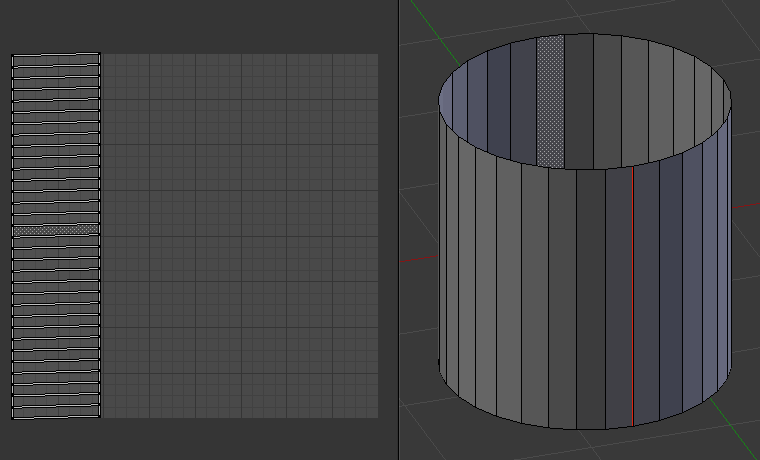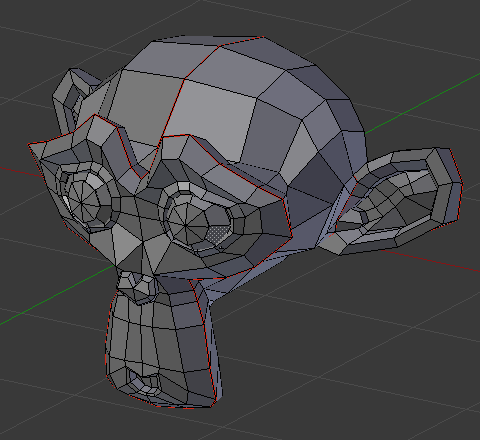缝合边¶
在许多情况下,使用方形、柱形、球形或常规 “展开” 操作的展开计算能够生成良好的 UV 布局。但对于更复杂的网格,尤其是有大量凹陷的网格,您可能需要定义一条 接缝 来限制和引导展开操作。
就像缝纫一样,接缝是图像/布料两端缝合的地方。在展开过程中,UV 贴图在接缝处是不连续的。把这种方法想象成剥橘子皮或剥动物皮。您可以在橘子皮上切一刀,然后把它剥下来。然后将其压平,施加一定程度的拉伸。这些切口和接缝是一样的。

圆柱上的简单缝合线。¶
在使用这种方法时,您需要清楚拉伸的程度。缝合线越多,拉伸越少,但会给贴图流程带来麻烦。最好是在保证最小拉伸的前提下,尽可能少用缝合线。设法让缝合线藏在不可见的区域。在使用三维绘制的产品中,这就变得不是什么大问题了,因为投影位置可以轻松处理缝合线,二维贴图则相反,匹配不同 UV 孤岛的边线是很困难的。
工作流程如下:
标记缝合边。
展开。
反复调整缝合线。
手动调整 UV。
标记缝合边¶
参考
- 编辑器:
3D 视图
- 模式:
编辑模式
- 工具:
- 菜单:
参考
- 编辑器:
UV 编辑器
- 模式:
视图模式
- 菜单:

标记了缝合线的苏珊娜。¶
只要选中边,然后按下 Ctrl-E 并选择 标记缝合边 即可将一条边标记为缝合线;使用 Ctrl-E 并选择 清除缝合边 即可清除标记。
在上面的例子里,选择背面的边为缝合线(以隐藏缝合线),并使用了默认的展开算法。在 UV 编辑器中,可以看到所有的面都被整齐展开,就像用剪刀裁开缝合线,然后展开布匹一样。
在标记缝合边时,您可以在面选择模式下使用选择相连元素检查您的工作。此菜单选项会选择与所选面相连的所有面,直至接缝。如果选择的面超出了预定的接缝,说明接缝不连续。不过,您并不需要连续的接缝,只要它们能解决可能拉伸的区域即可。
就像剥皮有很多种方法一样,决定缝合线位置的方式也很多。一般来说,你应该想象你一只手抓着物体,然后一只手拿着锋利的剪刀,你想把它切开,然后铺在桌面上,并尽可能减少撕扯。可以注意到,我们标记了耳朵的外部边缘为缝合线,以分开耳朵的正面和背面。猴头的眼睛是断开的子网格,所以它们会自动展开。一条缝合线垂直经过后脑勺,头部一分为二被摊开。
缝合线的另一个用处是限制展开的面。比如,在制作头部贴图时,你不需要为顶部和后脑勺的头皮添加贴图,因为它会被头发盖住。所以可以在发际线位置定义一条缝合线。接着,选择一个前额面,然后在展开前选择相连的面,一直向上宣导发际线缝合线,这样头皮就不会被展开了。
在展开对称物体时,比如头部或身体,沿对称轴标记缝合线。比如,从前视图中间劈开头部或整个身体。在展开时,可以把两个半边重叠到同一个纹理空间,这样右手和左手可以共用图像像素;左脸匹配右脸,等等。
Note
不要妄想 “一次展开可以完美适用于所有场合”。就像我们在后面要讨论的一样,你可以轻易地从网格的不同区域,使用不同方法展开多个 UV。
沿孤岛边界生成缝合边¶
参考
- 模式:
视图模式
- 菜单:
将现有 UV 孤岛边界标记为缝合边,可用于修改已展开网格的 UV。